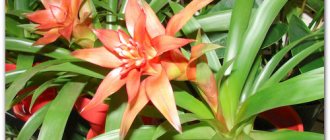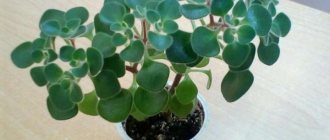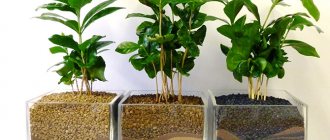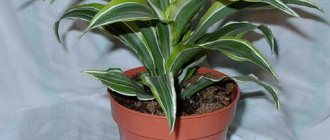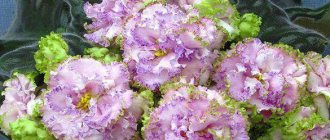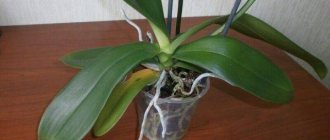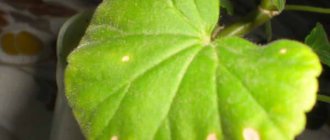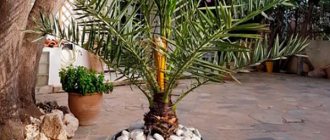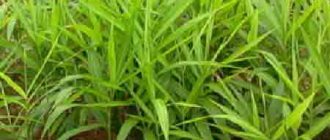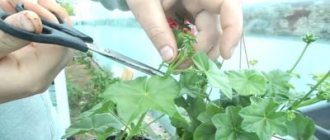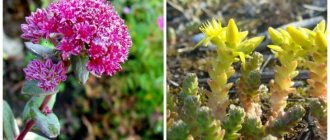Home — Botany — Houseplants — Turning the house into a tropical garden — basic recommendations for caring for Guzmania
The Guzmania indoor flower is an epiphyte from South and Central America. In nature, it grows on dying trees and receives moisture from the air. In indoor culture, this is an ordinary potted plant, quite unpretentious, but requiring compliance with several simple conditions.
The bright bracts are mistaken for flowers. Real Guzmania flowers are inconspicuous and short-lived.
The plant is evergreen tuft of long leaves with a bright, beautiful pre-flower and a short-lived flower. Guzmania is valued precisely for the leaves surrounding the flower - they can be pink, brownish and yellow, bright red and burgundy. In a room it rarely grows more than 40 cm, since it is problematic to provide “tropical” conditions in our homes.
Reed, aka Minor.
Popular types
Most often you can see a photo with reed Guzmania (aka Guzmania minor) - its distinctive features are bright bracts, shiny green leaves and the ability to bloom for a long time.
Tempo has light green leaves.
Common varieties also include:
- Mosaic Guzmania Guzmania musaica with 70-centimeter leaves forming a spreading rosette and a straight peduncle. Its leaves are decorated with brown and green stripes, and the bottom is colored red.
- Blood red Guzmania sanguinea - during the flowering period, all leaves (except for the outermost ones) turn bright red. The inflorescence of this species is not developed and is immersed in a rosette.
- Guzmania Donnell-smithii (donnell-smithii) has pale green scaly leaves and an erect flower stalk.
- Guzmania Tempo Guzmania Tempo, with light green leaves and bright bracts.
Blood red with luscious dark leaves and red spots of false flowers.
Description of succulents of the genus Mesembryanthemum
The name of the genus was given by the Polish naturalist Jacob Brain in 1684, denoting the succulent plants with the name Mesembrianthemum (“midday flower”). The name was given because the flowers opened at noon. Later, in 1719, the German botanist Johann Jakob Dillenius changed the genus name to Mesembryanthemum ("flower with a pistil in the center"). This name was assigned to the genus in the future. Popularly, these succulents are also called Ice plants because of the peculiarities of their appearance.
At first, many similar plants were classified as Mesembryanthemums, from which this genus grew to 2 thousand species. Later, after conducting research, botanists found that most plants, according to the rules of genus formation and their characteristics, cannot be classified as the genus Mesembryanthemum. As a result, 120 new genera were formed, and no more than 100 species remained in the Mesembrianthemum.
Representatives of the genus of succulent plants Mesembryanthemum are annual and perennial long-flowering crops. The plant is native to South Africa.
As a rule, these are ground cover succulents that are often used by gardeners to decorate rock gardens and other flower arrangements.
It is usually an annual or biennial herbaceous plant (therophyte), forming a mostly prostrate mat of stems with a maximum length of 10 to 60 cm. Small stem branches may be round, quadrangular or flat. The colors of the branches and leaves range from gray-green to bright red.
Photo of shiny succulent leaves (flickr.com)
A special feature of Mesembryanthemums are colorless shiny vesicular papillae on the surface of the leaf blades (more precisely, large white shiny leaf cells called idioblasts). In the sun they shine, resembling ice crystals, which is why the succulent got its other name. The leaves come in different sizes and shapes, depending on the variety.
The flowers are single or collected in small clusters, similar to daisies. Each has a width from half a centimeter to 6 cm or more. Depending on the species, the flowers are colored pink, white, yellow, red and open only on sunny days.
Mass flowering and long-lasting flowers are another feature of Mesembryanthemum. The flowering season lasts from spring to autumn. This plant is a hermaphrodite, so it can be both male and female. Pollinated by insects.
Most species of this genus are fast-growing, since they are annuals and must reproduce seeds during the growing season. They are often grown in gardens as ornamental plants for their showy flowers. At home, these succulents can be grown as perennial crops.
Basic requirements of Guzmania - light, temperature, humidity
Even such an unpretentious home flower as Guzmania requires compliance with certain conditions.
Many amateur aquarists breed angelfish at home; it is not difficult. How many people know what this name of popular aquarium fish means?
Look right now how beautiful and unusual the ordinary garden lilac is!
So, it is placed on western or eastern windows, in partial shade . Guzmania can only be moved to the south side in winter - this compensates for the natural lack of light.
Important! There is no need to place this delicate epiphyte on the windowsill. During the heating season it will die due to low humidity, and in summer direct sunlight will cause severe burns.
As for the temperature , even novice gardeners will not have problems here: in summer 20-25 degrees is enough, and in winter - no lower than 17. If the temperature drops to 16 degrees, the plant may get sick or not want to bloom.
The Morente look seems to imitate the colors of autumn.
to humidity , because it comes from the tropics. In summer, take it out onto the loggia, and in winter, a lighted bathroom may be a suitable place. You can place a humidifier or indoor fountain nearby. Regularly add water to the pan, but do not let it stagnate. Guzmania will also like spraying - and in the heat, “showers” can be carried out 2 times a day.
Lemon guzmania with bright yellow bracts.
Planting and caring for the Mesembryanthemum succulent in open ground
If you decide to grow a flower as a garden plant, you need to familiarize yourself with some nuances. Plants of this genus are not frost-resistant and are grown in open ground as annual flower crops.
Planting Mesembryanthemum seeds for seedlings
You need to start growing by sowing seeds in a container. Three months before the expected last frost, prepare a container for seedlings and fill it with soil mixture. Sow seeds on the surface at a rate of approximately 10 seeds per container. Do not cover the seeds with soil as they require light to promote germination. The seeds will germinate in about three weeks at temperatures between 18 and 24°C. Once the roots have taken root in the container, the seedlings can be pulled out and planted in individual pots and grown in cooler conditions for another 10-15 days to acclimate and strengthen. Replant outdoors after the last frost.
You can learn more about planting seeds for seedlings in this video
Sowing seeds in open ground
You can sow after the last frost and until mid-spring. The distance between plants should be from 15 to 25 cm. Larger varieties should be placed at a distance of about 20–30 cm from each other. It is best to sow the seeds on the surface in a sunny part of the garden that has good drainage.
How to care for Mesembryanthemum in open ground
If planted correctly in a good location and in well-drained soil, you should have no problems caring for your succulent flower in the future. Check out some expert tips for caring for Mesembryanthemum.
- Despite the drought resistance of the succulent, remember that all living things need water. During the hottest summer months, water deeply once a week. This will simulate the rain pattern in South Africa, where it rains mostly in the summer.
- Before planting succulents in open ground, add good quality organic fertilizer to the soil in a 2:1 ratio. This can be well-treated manure or vermicompost.
- You can “mulch” the soil around the flowers with fine gravel. This helps both the stems and roots as the gravel retains adequate moisture and allows good air circulation around the stems. If gravel is not available for mulch, medium-textured bark pieces will do.
Rules for watering and fertilizing
Caring for Guzmania at home means maintaining an optimal microclimate and proper watering. The main recommendations here are:
- a small amount of water is poured directly into the outlet, and the remaining water is removed after a few minutes;
- water the soil rarely - only if it is very dry;
- In winter, 1-2 waterings per week are sufficient, and in summer, daily watering is required;
- overwatering is more dangerous for Guzmania than overdrying;
- For spraying, use only clean water, and to remove dust, the leaves are occasionally wiped with a cotton swab.
The magnificent Donella-Smith.
When Guzmania blooms, it needs mineral supplements . It is worth buying a special complex for bromeliads that dissolves in water. Fertilizers in the form of a solution are also applied to the outlet. The frequency of feeding is once a month.
Interesting! If Guzmania is in favorable conditions, but does not bloom, then place apple slices in a bag on the ground (just make sure that they do not become moldy over time). The fruit will release ethylene and the plant will bloom very quickly.
Replanting Guzmania - when needed
The roots of the plant develop extremely slowly, and therefore it does not need regular replanting. But it’s still worth replanting Guzmania if:
- You purchased a flower in a transport pot . You need to prepare a wide pot, up to 15 cm deep, and place drainage at the bottom. A suitable soil mixture is a combination of coarse sand, sphagnum, peat and turf soil. Handle the roots carefully when transplanting. Lightly cover the relocated plant with soil and then water it.
- You separate the “baby” from the old bush . The replanting process is the same, but you will have to carefully separate the plant's root systems. The mother plant is not viable after flowering and is discarded.
Mosaic look. The transverse stripes on the leaves resemble a pike tail.
Popular species and varieties of the genus Mesembryanthemum
Currently, science knows about 100 species of this genus. We will briefly describe several of the most recognizable and common varieties.
Mesembryanthemum crystallinum
The flower is also called Crystal Daisy or Crystal Grass. Low growing creeping succulent. Forms a dense mat with a height of 7 to 12 cm, a width of 40 cm or more. It can be grown as an annual or perennial crop.
The leaves and stems are covered with small papillae, shining in the sun like ice crystals. The leaves are edible and can be eaten. They are very juicy and have a sour taste. Flowers range from white to pink or purple.
Also, domestic flower growers fell in love with several artificially bred varieties of this species:
- Mesembryanthemum crystal variety "Sparkles". The succulent has leaves that are whitish or yellow in color. The flowers will decorate your garden with the spectacular colors of their petals, reaching a diameter of about 5 cm.
- Mesembryanthemum variety "Harlequin". A special feature of this variety is its two-color petals, usually painted in shades of pink and orange.
- Cultivar Mesembryanthemum Limpopo. It is a spreading bush up to 15 cm high. The leaves are small, oval. The flowering season is from June to autumn frosts. Flowers up to 4 cm in diameter, of different shades with thin petals, 3-5 pieces in an inflorescence. Like the parent plant, the succulent's leaves and stems are covered in crystal-like hairs.
Mesembryanthemum gramineus
This succulent is better known as Dorotheanthus gramineus. In the West, this species is also called “African Dream”.
Photo of Mesembryanthemum gramineus or Dorodeanthus gramineus (flickr.com)
A tiny annual plant growing up to 10 cm in height. The leaves are elongated and green. The flowers of this species are pink in color with transitions from a dark center to lighter tips of the petals.
Mesembryanthemum cordifolium
Another name for the succulent is Aptenia cordifolia. A perennial groundcover with small, shiny, green, fleshy, heart-shaped leaves that sparkle in the sun.
The flower grows no higher than 10 cm, but can climb adjacent vegetation, hiding the trunks of trees and shrubs up to 2 meters high and forming a thick mat. It produces small bright pink flowers from spring to late summer, but can bloom almost all year round in tropical climates.
Mesembryanthemum nodiflorum
It is usually an annual plant, forming basically an outstretched mat or web of stems with a maximum length of about 20 centimeters. Pineal-shaped, cylindrical fleshy leaves up to 2 centimeters long grow from tiny stems.
The surface of the leaves is green to bright red and noticeably bumpy, with shiny, vesicle-like papillae. The flowers are solitary or collected in small clusters. Each is about half a centimeter wide with many narrow, thread-like white or yellowish petals.
Mesembryanthemum bellidiformis
The plant can also be found under the name Dorotheanthus bellidiformis. It is a low-growing annual with reddish stems and fleshy, elastic, grayish-green leaves covered with transparent hairs.
The succulent forms dense mats and in summer bears many bright flowers on peduncles about 7 cm long. The flowers open only in the sun and are painted in white, yellow, orange, red, pink, lilac, violet shades.
Mesembryanthemum nubigenum
The common name of the succulent is Delosperma nubigenum. The plant forms a low mat of fleshy leaves.
Small, starry yellow flowers appear in late spring. The foliage is thick, oblong or linear. The leaf is 3 cm long. This ground cover plant grows to only 7 cm in height, but can spread up to 90 cm.
Mesembryanthemum oculatum
The birthplace of the species is Namibia. The plant attracts the eye with its unusual color. The flowers are bright yellow, the central part is deep red.
How to prolong the pleasure - propagating Guzmania
Growing this tropical beauty is easy. But there comes a time when the flower dies and the plant loses its decorative effect. You can preserve the “tropical paradise” if you know how Guzmania reproduces .
Even during the flowering period, the plant forms a “baby” - usually one. The young flower grows very quickly and by the time the “parent” dies, it will already reach 15 centimeters in height. It is easy to know that a plant is ready to divide: the bract begins to dry out and the leaves turn pale.
Important! Before dividing, check that the children have roots. If they grow poorly, remove the peduncle in advance - this will stimulate their development.
After the mother plant withers, the children can be separated - this is done with a sharp knife. Baby Guzmania should be immediately planted in the prepared substrate, and the pot should be small, because the plant is small. Remember to use drainage to prevent your young plant from dying from overwatering. Reproduction of Guzmania is not difficult, so very soon you will be delighted with new bright flowers.
Anthurium - how to grow, how to care for, how to propagate. This indoor flower is called male happiness, and it is believed that it brings love and harmony between spouses to the house.
It turns out that aloe can be grown not only for health, but also for beauty. More details can be found here.
What to do with the huge aerial roots of indoor monstera? The answer to this question can be found at the link www.razmnojenie.ru/botanika/komnatnye-rasteniya/monstera.html.
Possible difficulties and diseases
Guzmania is easy to grow because it tolerates even unfavorable conditions. However, this plant also has its risks:
- The main pests that can affect Guzmania are: spider mites, scale insects. If parasites are found, wipe the leaves with soapy water, and if the infestation is severe, use insecticides.
- Regular waterlogging can lead to rotting of the root system.
- The plant may become infected with a fungus , as indicated by gray spots on the leaves. To get rid of it, you will need a fungicide.
The fungus began its destructive work from below.
